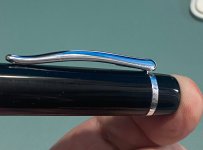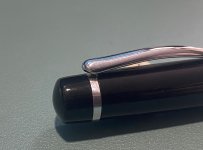PensFromNo11
Full Member
After some sound advice from Phil Dart (thank you) I worked out how to add a clip to my kitless pen caps. this encouraged me to have a go at a custom band too. It sort of worked (the photos are its best side) finishing was not great in parts but i think just practice will sort that.
But I have questions...
What the best way to attach the finial? - push fit and glue, thread in the finial or thread in the cap???
I used aluminium for my ring and I only have a wood lathe - is it possible (once ive mastered the ali) to turn sliver on my lathe?
thanks in advance
But I have questions...
What the best way to attach the finial? - push fit and glue, thread in the finial or thread in the cap???
I used aluminium for my ring and I only have a wood lathe - is it possible (once ive mastered the ali) to turn sliver on my lathe?
thanks in advance



